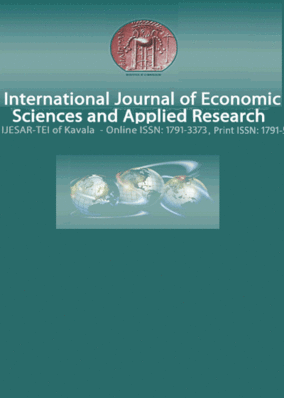Investment style of Jordanian mutual funds
Part of : International Journal of Business and Economic Sciences Applied Research ; Vol.5, No.2, 2012, pages 113-127
Issue:
Pages:
113-127
Abstract:
The study investigates the mutual funds investment style in the Jordanian context. It uses monthly returns of five mutual funds from July 2000 to December 2009. To do so, it employs the 4-factors model with explanatory variables the market portfolio return, a small minus large capitalization indicator variable, a high minus low book-to-market indicator variable, and a variable that account for momentum effect. These factors are used as benchmarks to investigate the investment style.The results indicate that mutual funds returns tend to follow those of the market portfolio. In terms of investment style, mutual funds managers tend to favor small capitalization stocks, past winners stocks, and low book-to-market ratio stocks, respectively.
Subject (LC):
Keywords:
mutual funds, 4-factors model, investment style, market portfolio, size, book-to-market, momentum
Notes:
Περιέχει διαγράμματα, πίνακες και βιβλιογραφία, JELclassification: C33, Gli, G23
References (1):
- Amman Stock Exchange, 2009, Annual Report. Available on: www.ammanstockex.com.Banz, R., 1981, The Relationship between Return and Market Valueof Common Stocks,Journal of Financial Economics, 9, pp. 3-18.Bulkley, G. and Nawosah, V., 2009, Can the Cross-Sectional Variation in Expected StockReturns Explain Momentum?, Journal of Financial and Quantitative Analysis, 44, 4, pp. 777-794.Carhart, M., 1997, On Persistence in Mutual Fund Performance, The Journal of Finance, 52, 1, pp. 57-82.Chan, K. C., Chen, H. and Lakonishok, J., 2002, On Mutual Fund Investment Styles, The Review of Financial Studies, 5, pp. 1407-143 7.Davis, J.L, 2001, Mutual Fund Performance and Manager Style, Financial Analysts Journal, 57, 1, pp. 19-27Daniel, K., Grinblatt, M., Titman, S. and Wermers, R., 1997, Measuring Mutual FundPerformance with Character istic-Based Benchmarks, The Journal of finance, 52, 3, pp. 1035-1058.Dickey, D. A. and Fuller, A. W., 1979, Distribution of the Estimators for AutoregressiveTime Series with a Unit Root, Journal of the American Statistical Association, 74, pp. 427-431.Eser, Z., 2007, Persistence of in Mutual Fund Performance, Unpublished DoctoralDissertation, Universty of Kentucky, U.S.A.Fama, E., & French, K., 1993, Common Risk Factors in the Returns on Stocks and Bonds,Journal of Financial Economics, 33, pp. 3-56.Granger, C. W. J., 1969, Investigating Causal Relations by Econometric Models and Cross-Spectral Methods, Econometrica, 37, pp. 424-438.Hu, H., 2005, Measuring Mutual Fund Performance with Characteristic-Based Benchmarks,Unpublished Doctoral Dissertation, Queen’s University Kingston, Canada.Im, K. S., Pesaran, Μ. H. and Shin, Y., 2003, Testing for Unit Roots in HeterogeneousPanels, Journal of Econometrics, 115, pp. 53-74.Jegadeesh, N. and Titman, S., 1993, Return to Buying Winners and Selling Losers: Implications for Stock Market Efficiency,The Journal of Finance, 48, pp. 65-91.Lee, F. and Rahman, S., 1990, Market Timing, Selectivity, and Mutual Fund Performance:An Empirical Investigation, Journal of Business, 63, 2, pp. 261-278.Levin, A., Lin, C. F. and Chu, C., 2002, Unit Root Tests in Panel Data: Asymptotic andFinite-S ample Properties, Journal of Econometrics, 108, pp. 1-24.Low, S., 2007, Malaysian Unit Trust Funds’ Performance during Up and Down Market Conditions.A Comparison of Market Benchmark, Managerial Finance, 33, 2, pp. 154-166.Saleh, W. and Bitar, A., 2009, Book-to-market, size, and Distress Risk, Journal of US-China Public Administration, 6, 5.Sharpe, W. F., 1992, Asset allocation: management style and performance measurement,Journal of Portfolio Management, 18, pp. 7-19.Stattman, D., 1980, Book Values and Stock Returns, Journal of Selected Papers, 4, pp. 25-45.Stotz, O., 2007, Selection, Market Timing and Style Timing of Equity Mutual Funds-Evidence from Germany,Zeitschrift fur Betriebswirtschaft, 1, pp. 51-73.Zhangpeng, G. and Rahman, S., 2005, Style analysis of Chinese funds, Applied FinancialEconomics Letters, 1, pp. 165-168.




